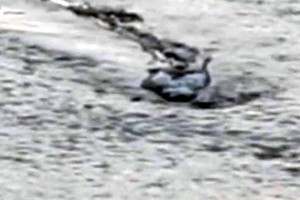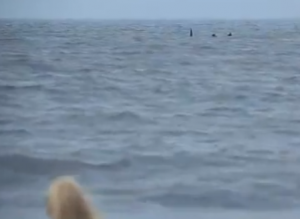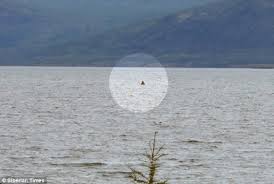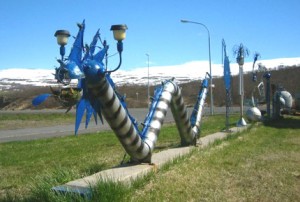LAGARFLJÓTSORMURINN
Lagarfljótsormurinn is a lake monster or worm which according to legend and recent tales lives in Lake Lagarfljótið in Fljótsdalshérað. The oldest recorded sighting dates back to 1345 and can be found in Jón Árnasons collection of folk tales. It is said the worm was a tiny heather worm which was placed on top of a gold ring. That supposedly made the gold grow or augment. When the ring’s owner, a young girl, came back to her treasure she saw to her horror that the worm had grown tre-mendously but the gold had not. Then she threw the worm and the gold ring in the Lagarfljót.
There are reports of sightings for some years in more recent times by visitors and locals, young and old. A well-known incident of a sighting occurred around year1980 when telephone cables were being placed across Lagarfljót between Hallormsstadur and Geitagerði which was quite a feat. Among other tools a depth gauge was brought along for recording the depth of the lake at the spe-cific location. The crew is said to have discovered the wyrm in a sort of cave, far below the over- hanging – bank on the eastern side of the Lagarfljót. The telephone cable was made of steel and covered by a strong protective layer, very stealthy and believed to be indestructible. But above the cave where the worm had been located the cable was damaged and torn twenty two times. Of course the worm is blamed for all those occurrences.
Skeptics will point out that in a lake like Lagarfljót residue and decaying plants settle at the bot-tom, and form marsh gases which can erupt and be seen in the form of dark arches resembling humps. A phenomenon which has likeness to the will-o´-the-wisp. That and the ridges of cliffs sur-rounded by water could possibly explain the legends of the Lagarfljóts-worm.
In his book Lagarfljót, Iceland´s greatest Water Body the author and biologist Helgi Hallgrímsson says: In olden times visions of the Lagarfljótsormur were considered to be an omen for bad tidings. In the century before this last one it has earned a new belief and few residents of Fljótsdalshérað will readily deny its existence. Some think of the wyrm as an emblem and a protective icon for the area of Fljótsdalshérað which has earned proper respect. That it is ordinarily invisible but can appear in different guises and claim it´s presence even with aid from natural phenomena yet is the privilege of psychic people to see it in its right form. Therewith The Worm in Lagarfljót has gained its rightful place which it may have had at the beginning of the settlement when wights were considered to be a natural part of existence.
The maiden found a heather worm, lay it on the ring and then hid it in her caskets. The worm guarded the gold for quite some days. When the girl came to look at her caskets the worm had grown so much they were about to burst. The young girl became so frightened she grabbed the caskets and threw them and all their contents into the lake.
Time passed and people soon became aware of the presence of the worm in the lake because it had taken to attacking and killing people and livestock by the lake. Sometimes it would stretch upon the shores of the lake and spew terrible poisonous fumes.
This caused great problems for the locals but no one knew how stop it or trap. Finally the people decided to beg the assistance of two Finnish shamans. They were to kill the worm and retrieve the gold. The two of them dove into the depths of the lake but soon returned to the surface. They claimed the problem was quite overpowering and killing the worm and retrieving the gold was too great a feat. They maintained that another worm was guarding the gold from below and that it was much more hazardous. They fastened the worm to the bottom of the lake with two great ropes. They fastened one behind its flippers but the other around its tail.
Since then the worm can harm no one, man nor beast, but occasionally it is said to have shot up its form and bare its tossing hump. Such appearances made a great impression and were considered to bode misfortune, such as the asperity of a cold season and grass failure. Those who do not believe in the existence of the worm say it is only a deception. They also claim to have truthful knowledge about the travels of a certain vicar who rowed his boat across where the worm supposedly rests, in order to prove the truthfulness of its nonexistence.
Icelandic folklore, legends and fairytales (1862)
Edited by Jón Árnason
This book presents an accurate overview of Lagarfljót – Lake, its vicinity, landscape, geography and historical context. It has a very interesting chapter about the the Lagarfljótsormur (worm, monster, – pages. 307-351) which no worm – enthusiast should pass by. The book is sold out in stores but can easily be found in public libraries.
Stories of Monsters in Eastern Iceland. An eastern collection of writings IV. Edited by Dagný Bergþóra Indriðadóttir. Skriðuklaustur publ. 2007. In this booklet are up to ten tales of the Lagar-fljótsormur, the seals and stingray which also are said to inhabit the lake. The booklet can be bought in bookstores, libraries and in Skriðuklaustur Museum.
Lagarfljótsormurinn, an illustrated. Written by: Huginn Þór Grétarsson
Óðinsauga útgáfa publ., Mosfellsbær 2010
http://www.odinsauga.com/previews/iclakewormprev.pdf
A class of students in Hallormsstadaskoli witnessed an appearance in Lagarfljót. Phylosopher
Gunnar Hersveinn met with them and dove into ”the wormologi” .
http://skoli.eu/umhverfis/austurland/
1. The artist Hringur Jóhannesson made a decorative work of art around four decades ago on the building of the late co-op KHB in Egilsstadir. There the worm can be seen shooting up its hump and tossing side to side.
2. Lagarfljótsormurinn a video made by Hjörtur Kjerúlf farmer in Hrafnkelsstaðir.
3. – 4. The names of the photographers who took theses photos are unknown but they were found on the Internet.
5. Sölvi Aðalbjarnarson is quite handy and has made metal sculptures of the Lagarfljótsormur worm. It stands next to his house in Einbúablá in Egilsstadir.
Participants leave from Egilsstaðir at 9.00 am. and ride across the Lagarfljótsbrú bridge, into Fell and on to Fljótsdalur, on through Hallormstaðaskógur wood and to Egilsstadir . From there partici-pants choose which distance they prefer but the finish line is in Egilsstadir.
The section called the Long Worm is a circle of 68 km. Riders go across the new bridge of river Jökulsá below Hjarðarból (north of Hengifoss) in Fljótsdalur. The first ca. 40 km the road is tarmac then there is a section of 20 km of gravel, then again on tarmac.
For this distance – both teams and individuals can compete. Teams are made up by three individuals and the so-called circle is divided into three sections, ca 26 km, ca 24 km and 20 km.
Hörkutólahringurinn is a circle of 103 km and via the same route. This race is for individual compet-itors only.
The race is part of the Ormsteiti, our annual local festival.
The race is twofold – that is categories of men and women and competitors age limit is 14.
See website UÍA – www.uia.is
Icelandic lake monster Lagarfljot Worm seen again
Lake monster seen in Iceland Original HQ uncut version
Iceland Loch Ness Monster footage is genuine. Panel authenticates film of Lagarfljótsormurinn.
Cryptids and Monsters: Lagarfljót Worm, the Iceland Worm Monster
https://www.youtube.com/watch?v=MmMjO…
Iceland Worm Monster Here? Lake Lagarfljot – Myth, Real or Hoax? July 7, 2012
Giant Snake? Is This The Legendary Worm Monster Of Iceland? Lagarfljóts Worm
https://www.youtube.com/watch?v=5U9khRVQ_sw
Such monsters have frequently been sighted but most often in the years of 1749 and 1750. From spring 1749 till autumn of 1750 they were seen on numerous occasions by respectable and decent individuals. Pétur, the legal counsellor of northern Múlasýsla shire and two others saw one close to Ketilsstaðir farm in Vellir but could not describe it. Two other men travelled there together and met with Pétur in Fell county. North of Arnheiðarstaðir farm they saw a beast moving along the lake, its size approximately one of a boat with six rowers; it moved with great haste; this was also seen by the people of Hrafnsgerði farm – which is nearby.
The third man travelled alone the same route as the other two. He told of a monster he had sighted right off the shore, seemingly a seal, its belly looking like the stingray when fished out of the sea; this beast tossed itself into water with much splashing. Those three men came to the farm Arnheiðarstaðir and told of what had occurred. When they were telling their tale all saw a monster on the shore close to the farm; it was thirty to forty fathoms long and had a tall hump on its back. One of the men claimed he saw tentacles emanating from both ends which reached into the lake.
All those men were decent and respected. In addition all the people at the Arnheiðarstaðir farm had witnessed the monster both far off and close to the farm but never seen it in close proximity to give a clear description. After this the people of Hrafngerði farm noticed three humps sticking out of the surface, for about a whole day, there were hundreds of fathoms between them, according to the tale told by the farmer.
One time Hans Wíum stayed the night in Arnheiðarstaðir farm, but in the morning he met with vicar Hjörleifur, vicar Magnús and vicar Grímur who were also there. The weather was calm, with gentle winds when they all saw across the lake a blowing of water as if by a whale, only larger, and close by there seemed as if a cairn was sticking out of the water. When they had watched it for a while, it turned towards shore.
Never have there been as many sightings as in the spring and summer of 1750; because then mon-sters were sighted in rivers running into the lake; three close to Hrafnkelsstadir farm, two had the likeness of horses, with whisks of hair sticking out from the back of their heads and having a hump on their back, seemingly black. One of them raised two muzzles and the water drained off between them. In addition one came ashore by Hreiðarsstaðir and the farmer there claimed its size amounted to a large house.
Such monsters have been sighted many more times such as in the spring of 1819. It was first seen close to the edge of the ice where the ice had not reached the shored, off Hafursá farm. According to speculations of those who observed the monster it was quite the distance off shore, in color of grey and in the shape of a horse standing on its head, abdomen up but no limbs or tentacles were visible. It was first seen on a Saturday; then it moved very slowly upstream, against the current and soft breeze up to and across from Hafursá farm there it disappeared the next Sunday. While this was occurring the ice was drifting north along the lake. Vicar Gunnlaugur in Hallormsstaður and farmer Hinrik in Hafursá farm witnessed this sighting and so did many others. One of those who saw it wanted to shoot it; but the others didn´t agree with him. There was no boat nearby and prob-ably would few of the onlookers have dared to get close to it, because they were no heroes except maybe the one who wanted to shoot it.
Íslenzkar þjóðsögur og æfintýri (bindi 1)
Guðbrandur Vigfússon
Dýrasögur
“Land snail, o land snail,
Slip out your middle horn,
I will give you a golden ring
For your every horn.”
.
Some people say that whether one covers gold by a land snail or heather worm both will grow in enormously until the worm becomes quite large and dangerous to people; if not handled hastily and with great care and the worm killed; because the worm grows obsessively fond of its gold. It would rather be dead than uncover its gold. From there stems the saying about misers who are stingy with their money “they guard their belongings like as if a worm with gold”. If the worms are allowed to stay alive, the stories state, they usually end up being thrown into lakes or rivers and there they dwell forever more. This same type of worm is in Lagarfljót lake in Múlasýsla shire, and both vicar Stefán and Eggert Ólafssons´ recognise this as true tale and so it shall henceforth be known. An-other worm of the same source is supposed dwell in the river Skjálfandafljót, a third in Hvítá river and the fourth in Skorradalsvatn lake. A similar one is said to reside in Surtshellir cave and therefore on dry land. The majority of such tales is quite similar to the one told about the heather worm be-longing to Thora Borgarhjorts in the legend of Ragnar Lothbrok.
Íslenzkar þjóðsögur og æfintýri (1862)
þjóðsaga, ritstjóri Jón Árnason
Its proportions are so great, his length is measured in stadions (ca.190 m.), thought strange it may seem. Some dare claim it has the length of a race (ca.1 km) or more. It is usually sighted at the same location, with its humps showing, sometimes three, at other times two and occasionally with only one.
This enormous creature has appeared from the deepest waters and shown itself, and has this kind of apparition has always been considered to be a bad omen or foreboding, for people believe it predicts
poverty, plague, the death of a noble man or such; its head or tail has never been seen. A tale is told, of a bishop or a holy shaman has tied it down, and I mention this as gossip of little value or rubbish.
But since then the creatures body had risen from the like at certain time sand been visible only for a short while to few people, and it was usually for about an hour or so; and after that time had elapsed it would slowly dive into the deep with great tremors, which did not damage buildings nearby, so houses collapsed as by an earthquake or sudden flooding of waters over opposite river banks, and so slowly calmed down. It is told that similar beasts or monsters of nature have been seen in other rivers and lakes in same counties yet not as large nor of similar shape. One of those is to be found in Lagarfljót and has the shape of the common seal, of huge proportions: what is left of shape reminds of an immensely large stingray……..
Íslensk annálabrot. Undir Íslands. Eftir Gísla Oddsson, biskup í Skálholti. Jónas Rafnar sneri á íslensku. Útg. Þorsteinn M. Jónsson, 1942. Bls. 66-67.






